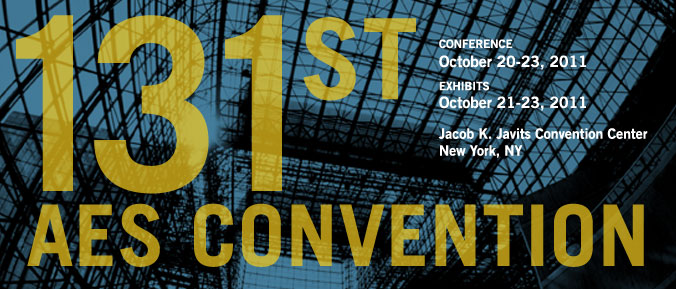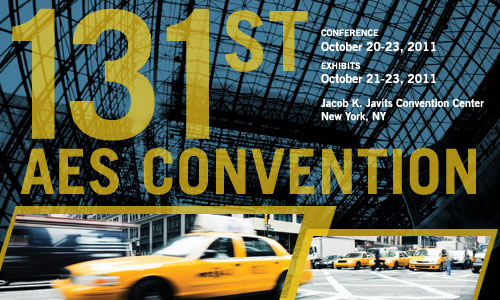
AES New York 2011
Paper Session P18
P18 - Headphone Playback
Saturday, October 22, 9:00 am — 12:00 pm (Room: 1E09)
Chair:
Jean-Marc Jot
P18-1 The Effects of Headphones on Listener HRTF Preference—Braxton Boren, Agnieszka Roginska, New York University - New York, NY, USA
Listener-selected HRTFs have the potential to provide the accuracy of an individualized HRTF without the time and resources required for HRTF measurements. This study tests listeners’ HRTF preference for three different sets of headphones. HRTF datasets heard over the noise-cancelling Bose Aviation headset were selected as having good externalization more often than those heard over Sennheiser HD650 open headphones or Sony MDR-7506 closed headphones. It is thought that the Bose headset’s frequency response is responsible for its superior externalization. This suggests that in systems where high quality headphones are not available, post-processing equalization should be applied to account for the effect of the headphones on HRTF reproduction.
Convention Paper 8537 (Purchase now)
P18-2 Head Orientation Tracking Using Binaural Headset Microphones—Hannes Gamper, Sakari Tervo, Tapio Lokki, Aalto University School of Science - Aalto, Finland
A head orientation tracking system using binaural headset microphones is proposed. Unlike previous approaches, the proposed method does not require anchor sources, but relies on speech signals from the wearers of the binaural headsets. From the binaural microphone signals, time difference of arrival (TDOA) estimates are obtained. The tracking is performed using a particle filter integrated with a maximum likelihood estimation function. In a case study the proposed method is used to track the head orientations of three conferees in a meeting scenario. With an accuracy of about 10 degrees the proposed method is shown to outperform a reference method, which achieves an accuracy of about 35 degrees.
Convention Paper 8538 (Purchase now)
P18-3 Observing the Clustering Tendencies of Head Related Transfer Function Databases—Areti Andreopoulou, Agnieszka Roginska, Juan Bello, New York University - New York, NY, USA
This study offers a detailed description of the clustering tendencies of a large, standardized HRTF repository, and compares the quality of the results to those of a CIPIC database subset. The statistical analysis was implemented by applying k-means clustering on the log magnitude of HRTFs on the horizontal plane, for a varying number of clusters. A thorough report on the grouping behavior of the filters as the number of clusters increases revealed a superiority of the HRTF repository in describing common behaviors across equivalent azimuth positions, over the CIPIC subset, for the majority of the HRTF datasets.
Convention Paper 8539 (Purchase now)
P18-4 Individual Perception of Headphone Reproduction Asymmetry—Juha Merimaa, Sennheiser Research Laboratory - Palo Alto, CA, USA; V. Ralph Algazi, University of California Davis - Davis, CA, USA; Richard O. Duda - Menlo Park, CA, USA
With headphone listening, the naturally occurring left/right asymmetry in head and ear shapes can produce frequency-dependent variations in the perceived location of a sound source. In this paper the perception of such asymmetry is studied by determining the interaural level differences required to center a set of narrow-band stimuli with different center frequencies. It is shown that the asymmetry varies from one listener to another. Some of the asymmetry can be explained with asymmetry in transmission of sound from the headphones to the entrances of a listener’s ear canals. However, the perceived asymmetry for individual listeners is also correlated between different headphone types including in-ear headphones that couple directly to the ear canals. The asymmetry is relatively stable over different times of wearing the headphones. The effect of correcting for the asymmetry ranges from imperceptible to substantial depending on the individual subject.
Convention Paper 8540 (Purchase now)
P18-5 Binaural Reproduction of Stereo Signals Using Upmixing and Diffuse Rendering—Christof Faller, Illusonic LLC - St-Sulpice, Swtizerland; Jeroen Breebaart, ToneBoosters - Eindhoven, The Netherlands
In this paper benefits and challenges related to binaural rendering for conventional stereo content are explained in terms of width of the sound stage, timbral changes, the perceived distance, and the naturalness of phantom sources. To resolve some of the identified issues, a two-stage process consisting of a spatial decomposition followed by dedicated post processing methods is proposed. In the first stage, several direct sound source signals and additional ambience components are extracted from the stereo content. These signals are subsequently processed with dedicated algorithms to render virtual sound sources by means of HRTF or BRIR convolution and to render an additional diffuse sound field with the correct inter-aural coherence properties based on the extracted ambience signals. It is argued that this approach results in a wider sound stage, more natural and accurate spatial imaging of sound sources, and resolves the “here and now” versus the “there and then” duality for room acoustic simulation in binaural rendering methods.
Convention Paper 8541 (Purchase now)
P18-6 Sound Quality Evaluation Based on Attributes—Application to Binaural Contents—Sarah Le Bagousse, Orange Labs - Cesson Sévigné, France; Mathieu Paquier, Laboratoire d’Informatique des Systemes Compexes - Brest, France; Catherine Colomes, Samuel Moulin, Orange Labs - Cesson Sévigné, France
The audio quality assessment is based on standards that mainly evaluate the overall quality to the detriment of more accurate sound criteria. On the other hand, a major problem of an assessment based on sound criteria is their meaning and their understanding that have to be the same for each listener. A previous study clustered a list of sound attributes in three main categories called “timbre," “space," “defaults." The work presented here is based on those previous results and aims at tuning a subjective test methodology of spatial audio quality. So the three families were included in a test dedicated to the assessment of spatial audio quality with binaural contents. The test was based on the MUSHRA method but using three anchors specifically to each attribute and without explicit reference. The original version was added as the hidden reference. The aim of the listening test described in this paper was to verify the relevance of those three attributes and their influence on the overall quality.
Convention Paper 8542 (Purchase now)
Information Last Updated: 20111005, mei

